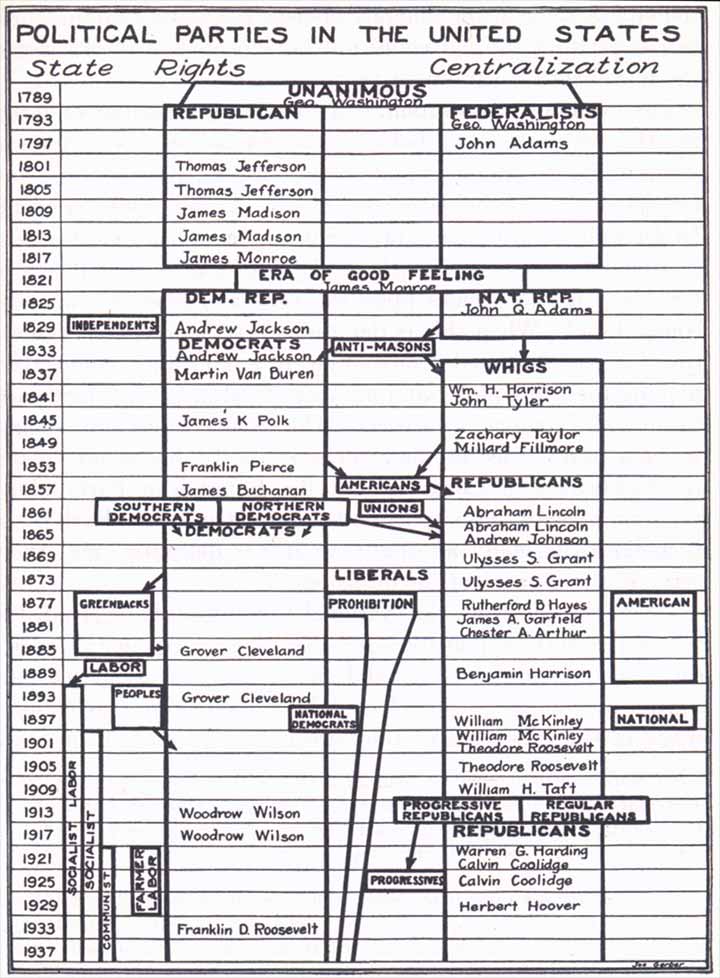
Originally Posted by
Mikebert

The GOP isn't the lynching party. The descendents of lynchers are now Republicans. They are Americans too and deserve representation. For a very long time the Democratic party represented their interests.
The coats work like this. In the beginning there were two factions, the Federalists and Jefferson's Republicans (also called Democratic Republicans). The Federalist died after 1816 and in 1820 America had only one party. So president Monroe in the election of 1820 was the only president since Washington to have have run unopposed. Historians call this period the era of good feeling because faction had (temporily) disappeared.
In the process of becoming the dominant party, a funny thing happened to the Democratic Republicans. They turned into Federalists. The Federalists had favored a tariff, a central bank (what we call the Fed today) a permanent Navy and a standing army. Democratic Republicans were opposed to all things things in 1800. By 1820, the Democratic-Republicans now favored all these things.
During the depression following the Panic of 1819, which many people blamed on the tight money policy of the central bank, a new faction calling themselves Democrats arose under the leader Andrew Jackson. The rest of the party, now called National Republicans, won the election of 1824, but went down in defeat in 1828. After that they started to call themselves Whigs.
So between 1820 and 1832, the Democratic Republicans split into two parties, the Democrats and Whigs. The Whigs were pretty much still the Federalists. Like the Fderalists their support was strongest in the Northest. The Democrats still had some of the libertarian positions Jefferson had run on in 1800, but were no longer pacifist. They favored a military strong enough to fight wars to drive Indians off their land, opening it for settlement. They also had accepted tariffs for revenue, not for protecting US industries. Democrats were strongest in the South and West.
The Democratic party was the dominant party. The Whigs only elected two presidents, Harrison in 1840 and Taylor in 1848. Both parties threw off splinter groups. The three most important are the Abolitionists (mostly Whigs who wanted to free the slaves), the Free Soilers (mostly Democrats who wanted free land for whites in the West so that they could form white-only states--they strongly opposed extension of slavery into these territories), and the Know Nothings (anti-immigrants).
The Whigs fell apart after the 1852 election. Abolitionists, former Whigs and Free Soilers united to form the Republican party in 1854. Their party was opposed to the extension of slavery outside of the South. Other Whigs took over the Know Nothings, converting them from a anti-immigrant to a patriotic party, which they called The American Party. They joined forces with the Republicans after the 1856 election.
So now we have the Republican party with two distinct wings. A left wing consisting of social liberals (abolitionists) and economic liberals (free soilers) and a right wing consisting of business interests (former Whigs) and patriotic nativists (Know Nothings). After the war they were the dominant party for a long time.
Southerners remained loyal to the Democratic party, who had supported their interests in the Civil War. Immigrants were not welcome in the Republican party (recall one of the founding groups was anti-immigrant) and they became Democrats. So the Democrats became a party of rural Southern Protestants and urban Northern Catholics.
For about 100 years after the formation of the Republican party, the American party system was very different from that in Europe. Rather than spliting on ideology, as European parties did and as the original Federalist/Republicans were split, the parties were hodgepodges of different groups. Both parties had "liberal" and "conservative" wings.
In the Republican party, racist Free Soilers coexisted with Radical Republicans who wanted to not only free the slaves, but give them forty acres and mule. On the Democratic side, Southern Baptists who detested popery coexisted with Roman catholics.
So Lincoln's new party was pro-little guy (they called for giving free land to ordinary guys) and stood against the entrenched power of the Southern "slaveocracy". They no longer favored a central bank. They went on to extend the franchise (to black men). All these things, standing up for the little guy, opposition to a central bank and extension of the franchise had been core anti-Federalist positions in 1800. This is the coat changing Lincoln is referring to. Actually it is only pieces of each others coats that got exchanged. Lincoln's Republicans still favored protective tariffs and government-sponsered infrastructure projects.
During the 20th century the two parties again exchanged pieces of each other's coats until they emerged as ideological entities by the end of the century. Today the Democratic party is the Left party and the Republican party is the Right party. The parties in the US have now returned to having distinct ideologies like the Federalist/Democratic-Republicans and like European parties. Again, another example of what Lincoln called coat changing.




